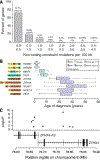Leveraging base-pair mammalian constraint to understand genetic variation and human disease
- PMID: 37104612
- PMCID: PMC10259825
- DOI: 10.1126/science.abn2937
Leveraging base-pair mammalian constraint to understand genetic variation and human disease
Abstract
Thousands of genomic regions have been associated with heritable human diseases, but attempts to elucidate biological mechanisms are impeded by an inability to discern which genomic positions are functionally important. Evolutionary constraint is a powerful predictor of function, agnostic to cell type or disease mechanism. Single-base phyloP scores from 240 mammals identified 3.3% of the human genome as significantly constrained and likely functional. We compared phyloP scores to genome annotation, association studies, copy-number variation, clinical genetics findings, and cancer data. Constrained positions are enriched for variants that explain common disease heritability more than other functional annotations. Our results improve variant annotation but also highlight that the regulatory landscape of the human genome still needs to be further explored and linked to disease.
Conflict of interest statement
Figures





Update of
-
Leveraging Base Pair Mammalian Constraint to Understand Genetic Variation and Human Disease.bioRxiv [Preprint]. 2023 Mar 10:2023.03.10.531987. doi: 10.1101/2023.03.10.531987. bioRxiv. 2023. Update in: Science. 2023 Apr 28;380(6643):eabn2937. doi: 10.1126/science.abn2937 PMID: 36945512 Free PMC article. Updated. Preprint.
Similar articles
-
Leveraging Base Pair Mammalian Constraint to Understand Genetic Variation and Human Disease.bioRxiv [Preprint]. 2023 Mar 10:2023.03.10.531987. doi: 10.1101/2023.03.10.531987. bioRxiv. 2023. Update in: Science. 2023 Apr 28;380(6643):eabn2937. doi: 10.1126/science.abn2937 PMID: 36945512 Free PMC article. Updated. Preprint.
-
Evolutionary constraint facilitates interpretation of genetic variation in resequenced human genomes.Genome Res. 2010 Mar;20(3):301-10. doi: 10.1101/gr.102210.109. Epub 2010 Jan 12. Genome Res. 2010. PMID: 20067941 Free PMC article.
-
Systematic discovery of conservation states for single-nucleotide annotation of the human genome.Commun Biol. 2019 Jul 2;2:248. doi: 10.1038/s42003-019-0488-1. eCollection 2019. Commun Biol. 2019. PMID: 31286065 Free PMC article.
-
An Evolutionary Perspective on the Impact of Genomic Copy Number Variation on Human Health.J Mol Evol. 2020 Jan;88(1):104-119. doi: 10.1007/s00239-019-09911-6. Epub 2019 Sep 14. J Mol Evol. 2020. PMID: 31522275 Review.
-
In Silico Functional Annotation of Genomic Variation.Curr Protoc Hum Genet. 2016 Jan 1;88:6.15.1-6.15.17. doi: 10.1002/0471142905.hg0615s88. Curr Protoc Hum Genet. 2016. PMID: 26724722 Free PMC article. Review.
Cited by
-
The shared genetic architecture and evolution of human language and musical rhythm.Nat Hum Behav. 2024 Nov 21. doi: 10.1038/s41562-024-02051-y. Online ahead of print. Nat Hum Behav. 2024. PMID: 39572686
-
Genome-wide copy number variation association study in anorexia nervosa.Mol Psychiatry. 2024 Nov 12. doi: 10.1038/s41380-024-02811-2. Online ahead of print. Mol Psychiatry. 2024. PMID: 39533101
-
Rare variant contribution to the heritability of coronary artery disease.Nat Commun. 2024 Oct 9;15(1):8741. doi: 10.1038/s41467-024-52939-6. Nat Commun. 2024. PMID: 39384761 Free PMC article.
-
Unifying approaches from statistical genetics and phylogenetics for mapping phenotypes in structured populations.PLoS Biol. 2024 Oct 9;22(10):e3002847. doi: 10.1371/journal.pbio.3002847. eCollection 2024 Oct. PLoS Biol. 2024. PMID: 39383205 Free PMC article.
-
Comparative Population Genomics of Arctic Sled Dogs Reveals a Deep and Complex History.Genome Biol Evol. 2024 Sep 3;16(9):evae190. doi: 10.1093/gbe/evae190. Genome Biol Evol. 2024. PMID: 39193769 Free PMC article.
References
MeSH terms
Grants and funding
- U01 MH116438/MH/NIMH NIH HHS/United States
- U41 HG002371/HG/NHGRI NIH HHS/United States
- R00 HG010160/HG/NHGRI NIH HHS/United States
- R01 HG008742/HG/NHGRI NIH HHS/United States
- DP1 DA046585/DA/NIDA NIH HHS/United States
- R01 MH118278/MH/NIMH NIH HHS/United States
- U01 HG011720/HG/NHGRI NIH HHS/United States
- R01 MH124839/MH/NIMH NIH HHS/United States
- F30 DA053020/DA/NIDA NIH HHS/United States
- R01 ES033630/ES/NIEHS NIH HHS/United States
- R35 GM147789/GM/NIGMS NIH HHS/United States
- R37 CA218570/CA/NCI NIH HHS/United States
LinkOut - more resources
Full Text Sources

